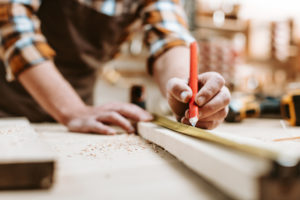How to Install Baseboards
Adding in baseboards is the easy way to add personality to a room. It also has many other practical benefits such as safeguarding against vacuum cleaners and bumps, creates the appearance of a smooth finish as well as keeps dirt from accumulating in the gap between walls and floors.
Baseboard trim is usually between 2-8 inches in height and may come together in one piece or in singular pieces. Depending on the width size of a baseboard, it will allow you to create more intricate designs on the wood. There are different types of materials that can be used when installing baseboards such as wood, MDF, vinyl and plastic. Each material has a different set of pros and cons which may include ease of painting and maintenance work overtime.

Nevertheless, the process of installing baseboards, similar to installing crown moulding, can be easy to do with the proper project guides. Follow the steps below to learn how to install baseboards fast and simple.
1. Remove Old Baseboard (if applicable)
There are a couple of steps in order to remove a baseboard properly. First, you will need to cut away the old paint along the top of the trim. Next, pull away from the old trim with a crowbar. Remove any of the remaining nails that are left in the drywall. Lastly, make sure the surface is clean by scraping and sanding off any residue left on the wall.
2. Collate All Supplies
Be sure to have all the supplies bought and set aside during this process. Before purchasing measure the perimeter of the room with a tape measure, rounding to the nears whole foot dimension divisible by two. Be sure to measure each wall at least twice. It is important to note that if you are a beginner add six inches to your total measurement to allow for leeway.
Baseboards typically consist of a couple of different components specifically cap mouldings, baseboards and shoe moulding. Be sure to determine which components you will need before starting to install your baseboards.
Lastly, you will need a mitre saw/mitre box in order to cut the pieces accordingly. If you do not own these saws there is always an opportunity to rent them from local hardware stores.
3. Prepping the Baseboards
Be sure to measure and cut the baseboards for each location they will be installed. The baseboards that meet the outside corners be sure to cut them a little bit longer to allow for the mitre cuts. Be sure to paint the baseboards and let them dry before installing.
4. Levelling
Use a foot level to determine if your floor is levelled – if not find the lowest point in the room and tack a scrap piece of the baseboard to the wall. Use the top of the scrap baseboard for reference to make horizontal marks every few inches down. Be sure to stay level as you move down the wall.
5. Outside Corner Cuts
To begin, start with fitting the end of one baseboard against the inside corner of the wall. At the other end draw a vertical line up the back of the board. Next, use the edge baseboard corner to guide the pencil. Place the board against the corresponding wall. Be sure to mark this the same way. The saw angle should be the opposite of the previous board in order to match up properly. Next, it is important to cut about 1/16-inch longer than necessary.
Before applying the wood glue and finishing nails place both boards back against the wall to double-check.
6. Adding a Scarf Joint
A scarf joint is a method of joining two baseboard ends together against the wall. To do so, mitre at the end of the baseboard at a 45 degrees angle in opposite directions. Be careful when adding the glue to overlap the mitres and then nail through the piece that covers the joint.
7. Finishing
Lastly, install shoe or cap moulding if applicable. Caulk along the edge and corner edges and nail holes. Be sure to clean the surface area before touching up the baseboards with primer paint. Once that has dried apply the final coat of paint.
Installing baseboards usually is a quick and easy process that can help transform the appearance of a room quickly. Be sure to visit The Royal Wood Shop for all your supply needs. Contact us today for more information!

I found this very interesting!
Thank you – glad you enjoyed it!